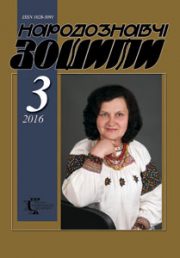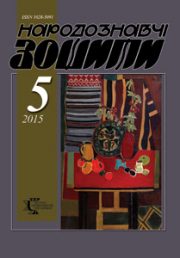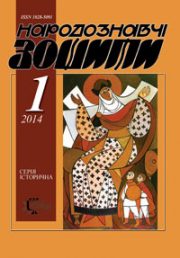The Ethnology Notebooks. 2017, 5 (137), 1126—1133
UDK 394.262.5 (477.86)
DOI https://doi.org/10.15407/nz2017.05.1126
Serebriakova Olena Georgiivna, Ph.D in History, junior research fellow
at the Department of Ethnology of the Present
at the Institute of Ethnology
of the National Academy of Sciences of Ukraine
Svobody Avenue 15, Lviv, 79000, Ukraine
Contacts: Tel. (096) 3826502; e-mail: o-sereb@ukr.net
ORCID ID: https://orcid.org/0000-0002-1039-2920
Abstract. Local Pokuttia`s beliefs, ritual prohibitions, customized instructions connected with the winter rituality are characterized in the article on the basis of ethnographic sources from the end of XIX — the early XX century and modern field exploration data.
Keywords: Poluttia, beliefs, signs, prohibitions, instructions, customs.
Received 20.07.2017
REFERENCES
Arkhiv Instytutu narodoznavstva NAN Ukrainy. F. 1. Op. 2. Od. zb. 698. Ark. 1—116.
Arkhiv IN NAN Ukrainy. F. 1. Op. 2. Od. zb. 704. Ark. 1—399.
Bojko, V. (1985). Selo Hlybivka. Al’manakh Stanislavivs’koi zemli, 2. N’iu-Jork ; Paryzh ; Sidnej; Toronto [in Ukrainian].
Isakiv: istorykokraieznavchyj narys (2004). Ivano-Frankivs’k : Nova Zoria [in Ukrainian].
Klodnyts’kyj, O. (1975). Narodnyj pobut, zvychai i fol’klor Tovmachchyny. Al’manakh Stanislavivs’koi zemli. N’iu-Jork ; Toronto ; Miunkhen [in Ukrainian].
Petryshyn, V. (1985). Sche pro selo Hostiv. Al’manakh Stanislavivs’koi zemli, 2. N’iu-Jork ; Paryzh ; Sidnej ; Toronto [in Ukrainian].
Kolberg, O. (1882). Pokucie. Obraz etnograficzny (Vol. 1). Krakόw : W drukarni uniwersytetu Jagiellońskiego [in Polish].
Mroczko, K. Fr. (1897). Śniatyńszczyzna: przyczynek do etnografii krajowej. Przewodnik naukowy i literacki,25 (4), 289—304 [in Polish].
Waigel, L. (1977). Rys miasta Kołomyi. Kołomyja : Drukiem H. Zadembskiego i spólki [in Polish].






